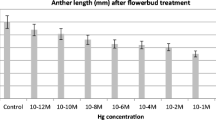Abstract
The effects of corn pollen and aqueous leachates of pollen upon the radicle growth ofBidens pilosa, Cassia jalapensis, andRumex crispus are shown. Extractions of pollen with various solvents and methods were carried out so as to assess its active principle and its effect uponC. jalapensis. The preliminary steps to separate and identify the allelopathic compounds of the sonicated and macerated pollen extracted with methylene chloride are described. The strongest inhibitory effect was produced by the hexane fraction. The allelopathic effect of corn pollen upon the growth ofC. jalapensis in several substrates is shown. The possible structure of some of the active fractions is discussed as well as the possibility that the allelopathic potential of pollen might actually occur in nature.
Similar content being viewed by others
References
Altieri, M.A., andDoll, J.D. 1978. The potential of allelopathy as a tool for weed management in crop fields. PANS 24(4):495–502.
Chacon, E.J.C. 1978. The concept of “mal y buen monte” and its relation with allelopathic potential in traditional agroecosystems in the Chontalpa, Tabasco, Mexico. Professional thesis. C.S.A.T. Cardenas, Tabasco, Mexico, 58 pp.
Einhellig, F.A., andRasmussen, J.A. 1973. Allelopathic effects ofRumex crispus onAmaranthus retroflexus, grain sorgum and field corn.Am. Midl. Nat. 90:79–86.
Grodzinsky, A.M. 1965. Allelopathy in the Life of Higher Plants. Naukova Dumka, Kiev (in Russian).
Harborne, J.B. 1977. Introduction to Ecological Biochemistry. Academic Press, London.
Jiménez, — 1983. In press.
Khailov, K.M. 1974. Biochemical Trophodynamics in Marine Coastal Ecosystems. Naukova Dumka, Kiev (in Russian).
Kossanel, J.P., Marín, J., Annelle, P., Feinet, M., Vallet, J.K., andKurnes, K. 1977. Inhibition of growth of young radicles of maize by exudation in culture solution and extracts of ground root onChenopodium album L. pp. 77–86, in A.M. Grodzinsky (ed.). Interactions of Plants and Microorganisms in Phytocenosis. Naukova Dumka, Kiev. (In Russian with an English summary).
Litsinger, J.A.,andMoody, K. 1976. Integrated pest management in multiple cropping systems, pp. 293–316,in M. Stelly (ed.). Multiple Cropping. American Society of Agronomists.
Molisch, H. 1937. Der Einflusseiner Pflanze auf die andere Allelopathie. Gustav Fischer Verlag, Jena.
Putnam, A.R., andDuke, W.B. 1974. Biological suppression of weeds, evidence for allelopathy in accessions of cucumbers.Science 15:370–371.
Putnam, A.R., andDuke, W.B. 1978. Allelopathy in agroecosystems.Ann. Rev. Phytopathol 10:431–451.
Rice, E.L. 1979. Allelopathy—an update.Bot. Rev. 45(1):15–109.
Rice, E.L. 1974. Allelopathy. Academic Press, San Francisco, 343 pp.
Robinson, T. 1967. The Organic Constituents of Higher Plants, 2nd ed. Burgess, Minnesota.
Stanely, R.G. 1974. Pollen. Springer-Verlag, New York.
Tukey, H.R., Jr. 1969. Implications of allelopathy in agricultural plant science.Bot. Rev. 35:1–16.
Author information
Authors and Affiliations
Rights and permissions
About this article
Cite this article
Jiménez, J.J., Schultz, K., Anaya, A.L. et al. Allelopathic potential of corn pollen. J Chem Ecol 9, 1011–1025 (1983). https://doi.org/10.1007/BF00982208
Received:
Revised:
Issue Date:
DOI: https://doi.org/10.1007/BF00982208




